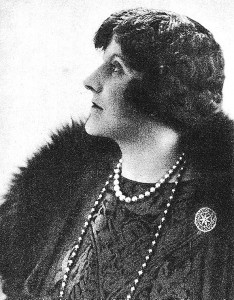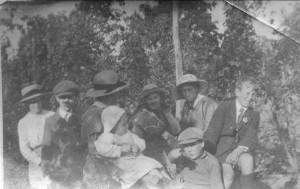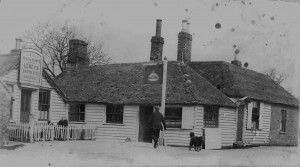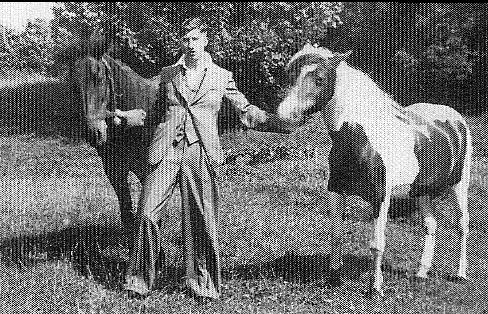By Arthur Woodgate
At 6.30 am. off we went along Wish Street where we met up with a friend of my mother, a Mrs Milton. We then met up with mother’s sister, Aunt Martha (I wonder why they called me Arthur!) and a crowd of Ryers. At the bottom of Leasam Hill – we all went up the grassed hill – how they got me up there, I don’t know, but the photo shows they did. As the year made me a bit older, I had to walk, so making my little legs rather tired. But I still met up with my friends and had a fun day. Now having got to Leasam Farm, some of us stayed, but some of the multitude went on to next door farm called “Lea” and off we went picking hops when the farm manager, Mr Neeves, shouted for work to begin.

The big house called “Leasam” was at one time owned and lived in by the Curteis Family – the ancestors of the “Burra” and “Bloomfield” families. This is where the overlapping of what I have written about our hospital site and “Saltcote” comes in. The family I knew most about was the Warrender Family, Sir George Warrender, Admiral and friend of King Edward the VII (who died just before I was born) or perhaps I should say the King was a friend of Lady Maud, Sir George has a chapel to his memory in the Rye St Marys Church.
I have previously mentioned the big amount of hops around this area and what I saw when much younger. I’m going to mention them again, but maybe from a different angle. It is because of the acres and acres of hops I have seen that I laugh when I think of the many new houses labelled “new” or “old” “Hop Garden or just, “The Hop Garden”, that I am confused as to which field were covered in hops and there are more than me that can remember nearly whole villages being hop gardens, albeit edged in with orchards and soft fruit beds – one can tell I’m right when they see so many Oast Houses still around, even if they have been converted to live in. If one travelled as I did when I was much younger, from the top of Flackley Ash, Peasmarsh north eastwards, one would have not got out of the sight, and smell, of hops. There was a tremendous amount of hops, a bit back in to Sussex or, should I say a long way back into Sussex, and the whole of Kent, I have seen evidence that hops had been all over Herefordshire. If I overlap a bit more in this article, I cant help it….so, here we go….
In 1917 when I was four years old, my dad was in France, Edward VII was now King and the First World War was just ending – that’s why he got called “Edward the Peacemaker”. His friendship with the Warrender Family was very well known, as were his visits to Lady Maud after the Admiral had died. A lot of people were aware that he stayed at Leasam House. Lady Maud was an active advantage to Rye – she was a good contralto singer and could be heard in the church choir – she also used her talent for charity goodwill raising lots of money for Rye causes – posters would be seen with “Songs by Lady Maud Warrender” on them. They had two sons, the eldest was in the Navy (I have forgotten his first name) we did not see so much of him but the youngest, Harold, many knew him extremely well, as he went around Rye, he used to say he was very proud to be a real Ryer. He was assistant Scout Master when I joined the 1st Rye Captain Cory’s own Troop in about 1920. Harold was also involved in other charities. The local Girl Guides were called “Lady Maud Warrender’s Own”. If I mention Leasam to some people, they will say “oh yes, I’ve been there ‘hopping’. I do not know if the big house and the farm were the same ownership but I assume so. I have a photo showing the farm manager, Mr Neeves, measuring the hops – they were paid for by measurement and not weight. There were lots of arguments because they could be shaken down in the measuring basket and the pickers would sometimes put their hands in and pull the hops up.
Harold Warrender, always seemed happy to be mixing with the common herd of Ryers, I expect Jimper would know more about this than I, as his dad and Harold were both officers in the Captain Cory’s Own and together in the boy scouts in the late 1920/30s. I had a photo of them together in uniform but sadly I have mislaid this maybe Jimper or his family may have one? Whilst looking through my photos I saw a reference to Lime Kiln Cottage at Rye Harbour -this got me thinking about the reference to Kiln Drive and other Kilns and I wonder, as Leasam is on the same lane as I have mentioned before, I willl carry on with what I’ve written and ignore the Harbour Lime Kiln Cottage for now [Perhaps someone else may know if lime was made at the Harbour?].
I have dithered a bit about Leasam so I will now explain what happened in the hop garden.

We who had signed on to pick hops for Leasam stayed on there but those who were picking at Lea went across two fields and down a rough lane, along a short piece of road to where there were more hops than Leasam. One can turn in all directions and see more and more hops so one can see how ridiculous it is to call a row of houses around there and call them “The Old Hop Garden”. This is where I laughed – I suppose it’s as funny that they in the “Malt House” (but maybe not quite!) seem to keep naming things, new or old – this or that seems queer to me. I haven’t heard of many “Old Orchards” or “New soft fruit plantation” or old “grazing field” – but I think it quite amusing that Mr Harmer should name his hairdressing salon in Iden, “The Country Hare” and not “Hair (Hare) in Iden” in a field with animals wondering about around it – Iden has at least two ways down to the river, so was at one time all part of the fishing that went on, when that river was part of he sea, but the river Rother now forms part of of the Kent-Sussex border. If we go down Iden lane and into Houghton Green, we come to Reighton Farm House on one side of the road and Reighton Oast House on the other, so hops were grown there and the farm would have joined up with the “Hooks” farm with a bit more ground, farmed by Mr Bates. Now we are back into Burra Land where the Hooks joins, Sand Rock Hill, which we know nowadays as “Burra’s Hill”. Some of Mr Bates’ ground would have been in the Artisan Golf Club, and a Rev. Mr Bates, a popular Vicar of Iden used to preach in Playden, although there was a Vicar of Playden – I can remember people walking up from Rye on a fine Sunday evening to hear him preach. Besides the Burra Family, I recall, there were other in the Hooks, not just the Bates, but also a well known family named Brodrick.
Now, going back to Reighton, we will go past the Peace and Plenty Pub (if its opening hours, go and have a drink). Reighton Oast (which I helped convert into a living house), was owned and occupied by the famous author, Mr Warren Chetham-Strode, who wrote the “Guinea Pig” and childrens television stories. He and his wife were extremely nice people, we got to know them very well. He had a great sense of humour and was very sociable. He sat by an open window watching me tiling the roof of a rounded porch, feeding me with toffees – He suddenly said “Arthur, you are an artist” – I did not agree but said to him I will accept “Artistan” but not “Artist” -whereupon he asked me the difference – I told him that I could not work without a rule and an artist didn’t need one – as I took my rule out of my pocket, he looked with a thoughtful grin and said he had not’ thought of that. Before I left him I never did get the meaning of his name, so “Whats in a name”?
Across the road in the old Reighton Farm House (Old didn’t remain to the name) there lived a retired General. General Metcalf had been in charge of Aldershot Army Camp and we were looking after his retirement home. His regiment had been the Royal Engineers which made me think it funny, but he told me that he wasn’t’ supposed to do or know anything. He also told me that was what Sergeant Majors were for and one had tried to teach him a few things before he came out but had failed. He was a another very nice person.
If we think of all the ground here having been once sea bottom, it is easier to understand what I am on about! If we turn right and turn out of Houghton Green and face towards Rye, we will come to a bungalow which was the home of a pay- gate keeper – the gate (like all the others in the area has gone) – the gates were there to keep the different farmers stock from straying and paying for the road surfaces to be up-kept, as they ran between land owners property which was one time sea bottom. Then to the steps that used to take Saltcod Street from the sea to the top of the street. The sea used to come right to the cliff then but go back a bit at low tide, but ships could unload there. Now turn back and go towards Kent, we come to the Starlock, a most interesting place – The river still ran by there, and when there was enough dry land, beside it there was a lock keepers cottage, a pay gate keepers house, and some provision for landing fish and the Star pub is still there but not now licensed. On from there we come to Iden Lock surrounded mostly by a sheep farm and where another pay-gate used to be and, where French green frogs still quack about around the junction of the River Rother and the Canal – turn round now and back to Reighton and back into Burra Land where we can have a look at the Peace and Plenty, at the top of Houghton Green. I do not know what has been happening to this lovely named pub which has got altered over the years but they tell me it now has be revamped and has extra features reminiscent of a French Tabac and has regained much of its former popularity – it stands on the important Rye, Iden, Peasmarsh triangle with a building on the opposite side of the road which, was at one time, a Post Office.
Back up Sand Rock Hill (“Burra’s Hill”) and as we pass “The Hooks” where beside a Burra, a Curties and a Farmer Bates and the well known man Brodrick lived (indeed one still does), we find on the other side in Springfield ground, a drill hall for the volunteer soldiers to practice. On to the centre of Playden and the church there became very popular under a vicar named Rev Shaw.
Playden has been famed for its industrious people for many years and still is today. We look at things inside a territory and consider them as one.
From the “Top of the Hill” once called “Kings Head” (as people in Rye would call it and the then landlord called it so – such a jolly idea – it means something (“Whats in a name”).

The “Peace and Plenty” a good name for an “off work relaxing take from Leasam Oast to Reighton Oast – now a circle round those four points, with a lot of imagination guided by the names inside that circle we see quite a community over the last few hundred years and not only the production of Hops and Fish but we can see Mutton and, quite likely Beef and Vegetables. Fish could be prepared and the word Kiln suggests brick and pottery production and, of course, some kilns could have been herring dees to smoke herring to make bloaters. Just inside our area we had a workhouse, a cemetery, a reservoir, a windmill (now gone) but the road is still Mill Road (take note, no New). That’s better, I expect but I’ve missed some possibilities but “what an area” – self supporting and still adding to its assets. In 1921 the memorial hospital was built and many years after, the motor ambulance depot was built in there and some flats called St Bartholemew Court were also put beside the hospital – what better place for a medical area, especially as a statue of the Apostle is in there.
